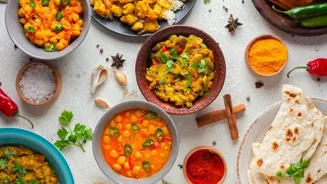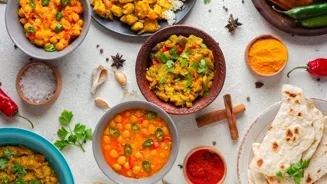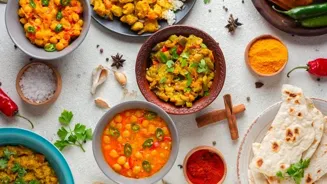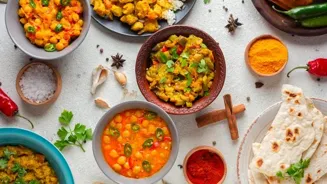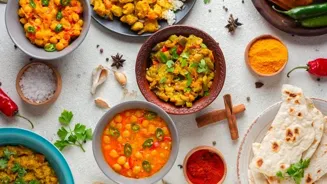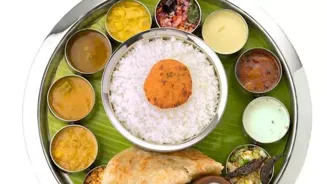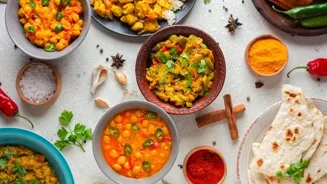Discover the colorful world of Indian Thali - a culinary journey through regional flavors and traditions. Dive into the symphony of tastes and textures on a single platter. Let's explore the art of Indian Thali together!
India, a land of vibrant cultures and diverse traditions, offers a culinary journey as fascinating as its history. Among the many gastronomic experiences India offers, the "thali" stands out as a comprehensive and satisfying introduction to regional cuisine.
More than just a plate of food, the thali is an art form, a balanced symphony of flavors, textures, and colors that reflects the unique culinary landscape of each Indian state.
It's a complete meal served on a single platter, typically stainless steel, though variations made of brass or even banana leaves exist. Let’s dig into the beautiful world of the Indian Thali.
Thali: A culinary tradition representing diverse flavors of India
The concept of the thali is rooted in the age-old Indian philosophy that a balanced meal should include all six rasas – sweet, sour, salty, bitter, pungent, and astringent. This ensures a complete sensory experience and provides the body with all the necessary nutrients.
Traditionally, the thali was a common way of serving food in Indian households, particularly during festivals and special occasions, as it allows for the presentation of a variety of dishes in an organized and visually appealing manner.
It’s a showcase of the region’s culinary heritage, offering a taste of everything from the staple grains to the exotic desserts. From North to South, East to West, each state boasts its own unique thali, reflecting the local ingredients, cooking styles, and culinary preferences.
A vegetarian thali's components, arrangement, and eating order
A typical vegetarian thali usually includes rice or roti (Indian flatbread), dal (lentil soup), vegetables (prepared in different styles), curd or yogurt, a sweet dish, and accompaniments like pickles and chutneys. The arrangement of dishes on the thali is also quite deliberate.
The accompaniments are usually placed around the edges, while the main course items are positioned in the center. This not only makes the thali visually appealing but also allows for easy access to all the dishes.
The order of eating is also often suggested or implied, starting with the milder dishes and gradually moving towards the spicier and more flavorful ones. The sweet dish is usually saved for the end, as a perfect finale to the meal.
Northern and southern Indian thalis offer diverse, flavorful dishes
In North India, you would find the Rajasthani Thali, famous for its Dal Baati Churma, a combination of lentil soup, baked wheat balls, and a sweet crumbly dessert.
Then, you have the Punjabi Thali, which often features dishes like Chole Bhature (chickpea curry with fried bread), Sarson da Saag (mustard greens), and Makki di Roti (cornbread).
Heading south, the South Indian Thali presents a colourful spectacle of rice, sambar (lentil-based vegetable stew), rasam (tomato and tamarind soup), and a variety of vegetable curries such as Avial (a mixed vegetable dish in coconut gravy) and Thoran (dry vegetable stir-fry).
Accompanying these are banana chips, papadums, and an array of pachadis (yogurt-based dips) and pickles.
Exploring regional Indian Thalis - Bengali, Assamese, Gujarati, Maharashtrian
Moving to the eastern states, the Bengali Thali often features dishes like Shukto (a bitter-sweet vegetable stew), Aloo Posto (potatoes cooked in poppy seed paste), and Dhokar Dalna (lentil cakes in gravy).
The Assamese Thali, on the other hand, is known for its use of fermented ingredients and unique dishes like Khar (an alkaline curry made with banana peels) and Masor Tenga (sour fish curry). In western India, the Gujarati Thali is a delightful mix of sweet, sour, and spicy flavors.
It often includes dishes like Dhokla (steamed chickpea flour cakes), Undhiyu (a mixed vegetable casserole), and Dal Dhokli (wheat dumplings in lentil soup). The famous Maharashtrian thali holds dishes include Puran Poli (sweet flatbread) and Varan Bhaat (plain rice with lentil).
Creating a thali at home celebrates Indian culinary diversity
Creating a thali at home can be a fun and rewarding experience. Begin by choosing a regional thali you'd like to recreate. Research the popular dishes of that region and gather the necessary ingredients.
Prioritize balancing flavours when selecting dishes, ensuring a mix of sweet, sour, salty, bitter, and pungent elements. Cook each dish individually, paying attention to the authentic recipes and cooking techniques.
Once all the dishes are prepared, carefully arrange them on a large platter, keeping in mind the traditional placement of each item. Serve the thali with a warm smile and enjoy the complete dining experience.
It's a celebration of Indian culinary diversity, bringing the flavors of different regions to your table.
